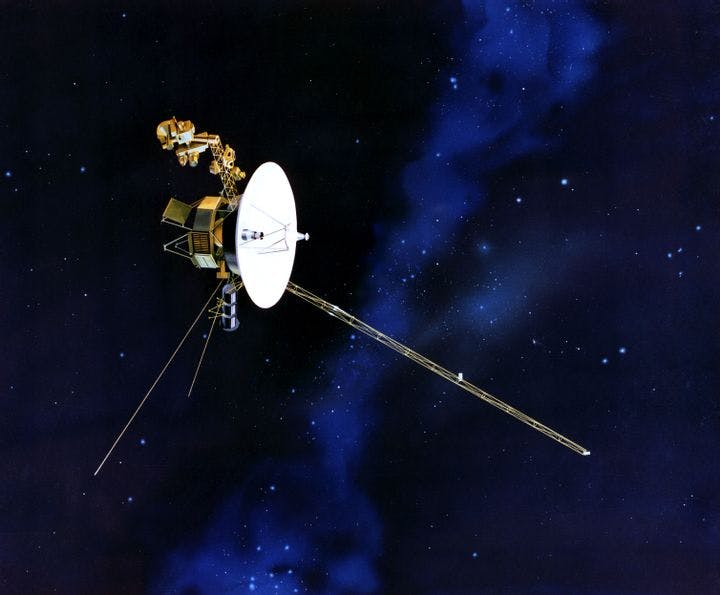Fall 2010
The Long Goodbye
– Eric Hand
What really propelled the two Voyagers to the edge of the solar system? A rare alignment of political will and technological know-how.
Several years after their launch in 1977, the twin spacecraft Voyager 1 and 2 flung themselves past Jupiter, using the giant planet’s gravity as a booster rocket. Thanks to this innovation of orbital mechanics—and a once-in-176-years alignment of the planets—Saturn and even Uranus and Neptune lay within reach.
But what really propelled the two Voyagers to the edge of the solar system, writes Arizona State University environmental historian Stephen Pyne, was a rare alignment of political will and technological know-how. The Voyager program was born just before the Cold War spirit—and dollars—of Apollo dissipated and just after key advances occurred in microprocessors and software. This coincidence ushered Voyager from the launch pad to the firmament—where today the twin probes still coast on as the “grand gesture” of an era that began with the space race of the late 1950s and ’60s.
In Voyager, a long and occasionally labored meditation on the nature and meaning of exploration,Pyne braids his narrative with anecdotes from the two earlier exploratory eras: the flood of 15th-century ships that Portugal unleashed in search of gold and glory, and the intracontinental journeys of the late 18th century, rooted in the science of the industrial age Enlightenment and exemplified by Alexander von Humboldt’s exploration of South America.
Parallels abound. Like Voyager’s mission managers at the Jet Propulsion Laboratory in Pasadena, California, Christopher Columbus had to hawk his plans for years to the powers that were before purse strings loosened. And, as with previous exploration missions, on which scientists were a rare luxury among soldiers and quartermasters, science was not all that was packed aboard Voyager. Of the two crafts’ total 1,817-pound weight, just 13 percent went to scientific instruments, with the rest going to other equipment and fuel.
But Pyne is also aware that the spacecraft tell a fundamentally different story. They are machines whose cameras have retrieved spectacular visions of dead places. These encounters contrast with the gripping (and often murderous) confrontations between earlier explorers and indigenous peoples. And while journeys of previous eras hewed mostly to the Odyssean ideal of the return, each Voyager spacecraft, having escaped the sun’s gravity altogether, will eventually exit the solar system and drift through the vast emptiness of the galaxy—perhaps outliving Earth.
Will the third age of exploration itself live on? After Voyager 1 took a last picture postcard of the solar system in 1990, the Voyager spacecrafts’ electronic eyes lidded shut. Today, their radio beacons pulse ever more wanly as their nuclear fuel runs out. Meanwhile, orbiting telescopes, parked near Earth, may have mooted future grand planetary tours like Voyager’s. Voyager discovered 26 new moons in total; the Hubble Space Telescope has discovered 48 around Jupiter alone. The deep of Earth’s oceans still beckons. Astronomers, with telescopes on the ground and in space, are hunting for the first Earth-like planet outside the solar system. And the Obama administration has pushed NASA to develop orbiting telescopes that will turn inward on Earth to study carbon cycles that are key to addressing climate change.
As enamored as he is of Voyager, Pyne understands that exploration can take these other forms. He writes of the moment in 1980 when Voyager 1 flew past Titan, the methane-shrouded moon of Saturn, whose soup of prebiotic amino acids and carbohydrates was supposed to illuminate something about Earth’s earliest history. But Titan’s murk remained mostly impenetrable to Voyager 1’s instruments. Meanwhile, wildfires raged around the Jet Propulsion Laboratory in the foothills of the San Gabriel Mountains. At the time, ecologists were just beginning to understand how inextricably life is linked to fire, which generates oxygen and hydrocarbon fuels, and, since humans have been around, often provides the spark of ignition. The wildfires offered a more vivid insight than Voyager into how life evolved on Earth. Later advances in astrobiology would come not from outer space, but from Earth’s frozen deserts and geothermal pools—when, observes Pyne, “new eyes viewed seemingly old worlds afresh.”
* * *
Eric Hand is a Knight science journalism fellow at the Massachusetts Institute of Technology and a reporter at Nature.
Reviewed: Voyager: Seeking Newer World in the Third Great Age of Discovery by Stephen J. Pyne, Viking, 444 pp, 2011.
Photo courtesy of Wikimedia Commons
